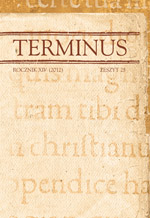Emblematyczne śpiewniki? O pograniczu między muzyką a obrazem w siedemnastowiecznych niderlandzkich zbiorach emblematów
Emblematic songbooks? A union of music and image in the 17th century Dutch emblem books
Author(s): Marcin PolkowskiSubject(s): Language and Literature Studies
Published by: Wydawnictwo Uniwersytetu Jagiellońskiego
Summary/Abstract: This article intends to trace the evolution of the Dutch songbooks and emblem books from the mid-16th century till the mid-17th century, with special emphasis on the period between 1600 and 1620, when a cross-over genre comprising both songs (or other lyrical genres) and emblems, made its appearance. If during the mid-to-late 16th century both the emblem genre and the songbook genre manifested itself within a separate, clearly distinct publishing tradition, then from the onset of the 17th century the northern Netherlands witnessed the emergence of a new type of publication: richly illustrated emblem books which contained songs and other types of lyrical poetry. In this article I first present a brief outline of the two genres (emblem books and vernacular songbooks), mentioning their main exponents, the functional features of the publications and the main aspects of their reception, until creation of a cross-over genre in Amsterdam around the year 1600. The innovative publishing concept of a dual songbook-emblem book pioneered by Amsterdam printers such as Dirck Pietersz Pers, was quickly adopted by other publishers, writers and editors. Books combining emblem imagery with songs became popular among young wealthy buyers among whom companionship went hand in hand with the enjoyment of various forms of oral literature. There were different functional approaches to the problem of combining emblemata with other genres, the most important of which are reviewed in this article. Some authors (e.g. Pieter Cornelisz Hooft) created a book comprising two symmetrical parts (emblems and songs or sonnets). Sometimes these parts were not symmetrical, but they nevertheless formed clearly distinct sections, for example in Roemer Visscher Sinnepoppen or Dirck Pietersz Pers Bellerophon. Other authors (e.g. Gerrit Hendrik van Breughel in Cupidos lusthof or Jan van der Veen in Zinne-beelden) placed the emblems at the beginning of each chapter of his book, where each of these chapters in itself comprised of a variety of lyrical genres, including songs. In this article the emblem genre is presented from the perspective of oral literature, pointing to the existence of a not yet entirely explored borderline area between emblems and song culture in the Northern Netherlands. Two examples of emblems from cross-over books of songs and emblemata analyzed in detail in this article are Gerrit Hendrik van Breughel emblem [18] from Cupidos lusthof (Den Pool,..), on standards of courtly behavior in the Commonwealth of Poland, and Jan van der Veen emblem [2] from Zinne-beelden (Trouwt vryicheyt aen vre…) which deals with questions of war and peace in relation to the identity of the Dutch Republic.
Journal: TERMINUS
- Issue Year: 14/2012
- Issue No: 25
- Page Range: 243-261
- Page Count: 19
- Language: Polish

